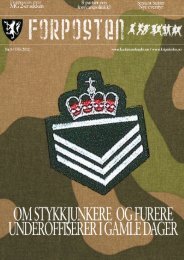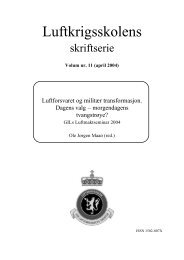Wilhelm Mohr
Wilhelm Mohr
Wilhelm Mohr
You also want an ePaper? Increase the reach of your titles
YUMPU automatically turns print PDFs into web optimized ePapers that Google loves.
<strong>Wilhelm</strong> <strong>Mohr</strong>. On World War II<br />
against the clear night sky. In this serious situation the Wing waited to<br />
be transferred while a landing strip was being prepared. At a ceremony<br />
the next morning, no field priest could have experienced more attentive<br />
Norwegians.<br />
The strain thus far had been significant work pressure, often with lack<br />
of sufficient sleep. There were sporadic German attacks here and there,<br />
but the Wing’s airfield had not yet come under attack. The increased<br />
tension could probably best be recognized by increased concentration<br />
and silence, even among those who normally were outspoken and lively.<br />
This was mixed with anticipation and the inspiration of being allowed<br />
to participate in the forthcoming events.<br />
Even from the initial phase of the invasion, the Norwegian aircraft<br />
stretched their area of operations deep into northern France, although<br />
the ground crews could not be transferred to the Continent until 16<br />
August. Then, vehicles and equipment were phased through the gathering<br />
area, shipped in on amphibious ships and transferred over the<br />
Channel. Before the transfer, the Wing had moved several times, from<br />
Bognor to Tangmere and then from there to Funtington, all in southern<br />
England. These movements naturally represented a burden in themselves,<br />
but at the same time they represented something close to a drill.<br />
During the movements the squadrons needed both to operate constantly<br />
and be ensured of the necessary technical support.<br />
The transfer to the Continent was delayed due to German resistance<br />
at the city of Caen. This was because the Wing’s allocated airstrip B16<br />
lay just north of the city. Finally the ground crews were underway, and<br />
the journey itself provided the personnel with a much-needed breathing<br />
space, although it was not without drama, as mines were still a real<br />
threat. This may have been witnessed with their own eyes as a large<br />
cargo vessel went down in the immediate vicinity of the troops. Uncertainty<br />
of a different nature related to their final destination. Caen had<br />
been taken on 9 July after 450 heavy bombers had been put to work,<br />
but the German 21st Panzer Division and parts of the 12th SS Panzer<br />
still represented a threat. We knew that the Canadian forces were still<br />
consolidating in the area. The Wing needed to be prepared for selfdefence<br />
and base defence.<br />
84
















